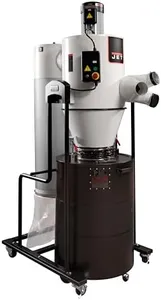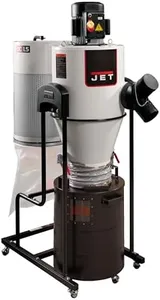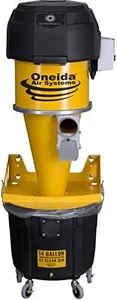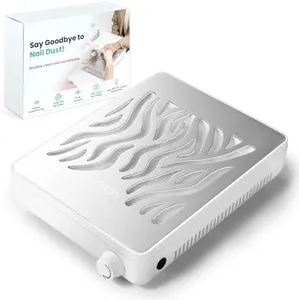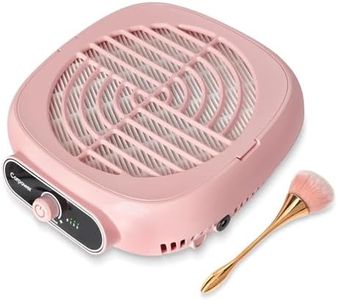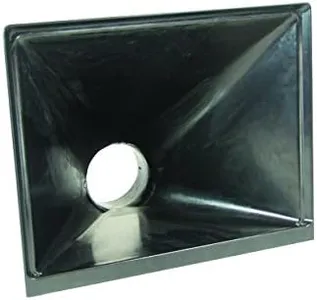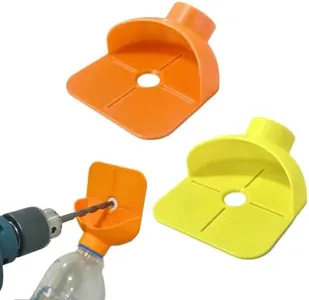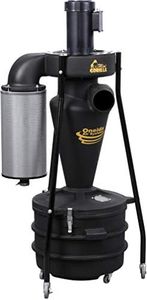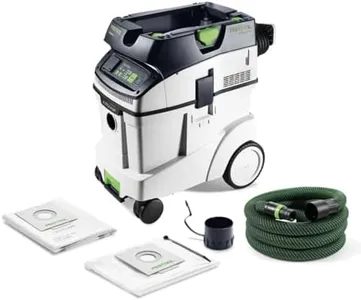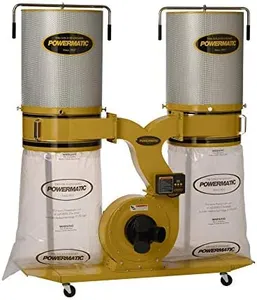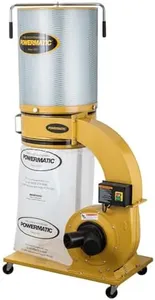10 Best Dust Collectors 2025 in the United States
Our technology thoroughly searches through the online shopping world, reviewing hundreds of sites. We then process and analyze this information, updating in real-time to bring you the latest top-rated products. This way, you always get the best and most current options available.

Our Top Picks
Winner
JET Cyclone Dust Collector, 2-Micron Filter, 3 HP, 230V 1Ph (Model JCDC-3)
Most important from
53 reviews
The JET Cyclone Dust Collector is a strong choice if you're looking for efficient dust management in a workshop or industrial setting. It offers impressive airflow at 1240 CFM, which means it can move a large volume of air to capture dust effectively. The two-stage cyclone separation system is a plus, as it helps remove heavy debris before the air reaches the filter, reducing clogging and maintenance. Filtration is solid, capturing 99% of particles down to 2 microns and 86% at 1 micron, which is good for improving air quality and keeping fine dust contained.
The dust collection capacity is excellent, with a large 66-gallon drum that’s easy to empty thanks to quick-release levers and wheels. This makes it convenient for extended use without frequent stops to empty the bin. Operating noise is around 76 decibels, which is noticeable but typical for dust collectors of this power. It's not the quietest, so consider that if noise is a major concern for your workspace.
Portability is decent given its size and weight (268 pounds), aided by eight swivel casters that allow moving it around despite being fairly large. The included RF remote control and timer function add convenience by letting you start or stop the system from up to 50 feet away and schedule automatic shutoff. The unit is quite heavy and bulky, so it’s better suited for a fixed spot rather than frequent moves. The 3 HP motor and 230V power requirements mean it’s designed more for professional or serious hobby use rather than casual home workshops. Also, while the filter cleaning system is manual, it is designed to be quick and user-friendly. If you need a powerful, efficient dust collector with high capacity and good filtration for medium to large workshops, the JET Cyclone is worth considering. Just be prepared for its size and noise levels.
Most important from
53 reviews
Festool 577872 Dust Extractor CLEANTEC CT 36 EI HEPA
Most important from
49 reviews
The Festool 577084 CLEANTEC CT 36 E HEPA Dust Extractor is a solid choice for both workshop and construction site use. It features a high-performance turbine that ensures consistently strong suction, which is crucial for effective dust collection. Its HEPA filtration is top-notch, capturing fine particles and making it suitable for environments requiring high air quality standards. The extractor’s 36-liter capacity is generous, reducing the frequency of emptying the container, thus saving time during large projects. Additionally, the antistatic function and smooth suction hose enhance user safety and ease of use.
The design promotes organization with a hose garage and cable windup, while the SYS-Dock allows for the convenient attachment of Systainers, improving portability and storage. Some users might find the 34-pound weight a bit cumbersome for frequent relocation. The unit can be retrofitted for greater convenience with a Bluetooth module, adding modern control options. Despite its higher price point, the Festool dust extractor’s build quality and performance make it a worthy investment, particularly for professional users who demand reliability and efficiency.
Most important from
49 reviews
JET Cyclone Dust Collector, 2-Micron Filter, 1-1/2 HP, 115V 1Ph (Model JCDC-1.5)
Most important from
64 reviews
The JET Cyclone Dust Collector is a solid choice for woodworkers and DIY enthusiasts looking for an efficient solution to manage dust and debris in their workspace. With a powerful 1-1/2 HP motor, it provides impressive airflow, effectively removing heavy particles thanks to its two-stage separation process. This design ensures that air movement remains strong while keeping heavy debris contained in the 20-gallon steel drum, which helps maintain suction over time.
One of the standout features is its filtration efficiency. The pleated filter captures dust particles down to 1 micron, which is beneficial for maintaining a clean environment and reducing health risks associated with fine dust exposure. The manual cleaning system also facilitates easy maintenance of the filter, ensuring that performance stays optimal.
Portability is another advantage, as the dust collector is equipped with swivel casters and quick-release levers. This makes it easy to relocate the unit within your workshop, allowing for flexibility in your workspace setup. Additionally, the remote control feature enhances convenience, enabling operation from a distance of up to 50 feet.
Most important from
64 reviews
Buying Guide for the Best Dust Collectors
Choosing the right dust collector is essential for maintaining a clean and safe working environment, especially in workshops or industrial settings. The right dust collector can help improve air quality, reduce health risks, and enhance the efficiency of your operations. To make an informed decision, you need to understand the key specifications and how they align with your specific needs.FAQ
Most Popular Categories Right Now


